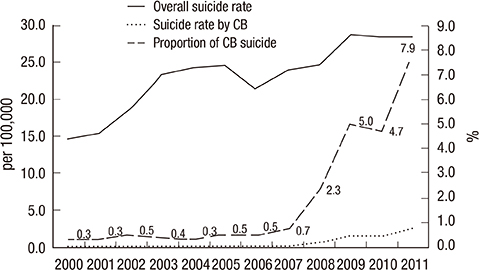J Korean Med Sci.
2014 Aug;29(8):1174-1177. 10.3346/jkms.2014.29.8.1174.
Trends and Risk Factors of the Epidemic of Charcoal Burning Suicide in a Recent Decade among Korean People
- Affiliations
-
- 1Department of Preventive Medicine, College of Medicine, Chung-Ang University, Seoul, Korea. wylee@cau.ac.kr
- 2Center for the Study of Suicide, Department of Psychiatry and Department of Criminology, Wayne State University, Detroit, MI, USA.
- KMID: 2129617
- DOI: http://doi.org/10.3346/jkms.2014.29.8.1174
Abstract
- The aims of this study were to analyze annual trends of charcoal burning (CB) suicide, 2000 to 2011, and to examine the risk factors of CB suicide in Korea. Data on suicides (n=138,938) were obtained from the Statistics Korea. The proportion of CB suicides among all suicide deaths reported was 0.7% (84 cases) in 2007, and since 2008 it has rapidly increased to 7.9% (1,251 cases) in 2011. Of significant risk factors of CB suicide, the presence of the media report of Ahn's suicide was the greatest risk factor (adjusted odds ratio, 11.69; 95% CI, 10.30-13.23) of the initial phase of the continuing CB suicides since 2008. Korean Government should urgently consider effective measures against CB suicide, including enforced media regulations on reporting such suicides.
Keyword
MeSH Terms
Figure
Cited by 1 articles
-
A social psychiatric approach to suicide prevention
Sung-Wan Kim, Min Jhon, Mina Kim, Jong-Woo Paik, Jae-Min Kim, Jin-Sang Yoon
J Korean Med Assoc. 2019;62(2):93-101. doi: 10.5124/jkma.2019.62.2.93.
Reference
-
1. The Organisation for Economic Co-operation and Development. OECD statistics. accessed on 1 January 2014. Available at http://www.oecd.org/statistics.2. Chung WS, Leung CM. Carbon monoxide poisoning as a new method of suicide in Hong Kong. Psychiatr Serv. 2001; 52:836–837.3. Mingpaonews. Under the influence of internet information from Hong Kong, the first case of charcoal burning suicide emerged in Taiwan. Mingpaonews. 2000.4. Chan KP, Yip PS, Au J, Lee DT. Charcoal-burning suicide in post-transition Hong Kong. Br J Psychiatry. 2005; 186:67–73.5. Ji NJ, Lee WY, Noh MS, Yip PS. The impact of indiscriminate media coverage of a celebrity suicide on a society with a high suicide rate: epidemiological findings on copycat suicides from South Korea. J Affect Disord. 2014; 156:55–61.6. Kim WJ, Song YJ, Namkoong K, Kim JM, Yoon HJ, Lee E. Does a copycat effect exist in the emergency department? Int J Psychiatry Med. 2013; 45:59–72.7. Phillips MR, Bertolote JM, Beautrais A, Yip PS, Vijayakumar L, Pirkis J, Hendin H. Reducing access in Asia to lethal means of self-harm. In : Hendin H, Phillips MR, Vijayakumar L, Pirkis J, Wang H, Yip P, Wasserman D, Bertolote JM, Fleischmann A, editors. Suicide and suicide prevention Asia. Geneva: WHO;2008. p. 69–75.8. Pan YJ, Liao SC, Lee MB. Suicide by charcoal burning in Taiwan, 1995-2006. J Affect Disord. 2010; 120:254–257.9. Kato K, Akama F, Yamada K, Maehara M, Kimoto K, Kimoto K, Takahashi Y, Sato R, Onishi Y, Matsumoto H. Frequency and clinical features of patients who attempted suicide by charcoal burning in Japan. J Affect Disord. 2013; 145:133–135.10. Kanchan T, Menon A, Menezes RG. Methods of choice in completed suicides: gender differences and review of literature. J Forensic Sci. 2009; 54:938–942.11. Lin JJ, Chang SS, Lu TH. The leading methods of suicide in Taiwan, 2002-2008. BMC Public Health. 2010; 10:480.12. Liu KY, Beautrais A, Caine E, Chan K, Chao A, Conwell Y, Law C, Lee D, Li P, Yip P. Charcoal burning suicides in Hong Kong and urban Taiwan: an illustration of the impact of a novel suicide method on overall regional rates. J Epidemiol Community Health. 2007; 61:248–253.13. Wasserman IM, Stack S. Lethal locations: an application of opportunity theory to motel suicide, a research note. Death Stud. 2008; 32:757–767.14. Chang SS, Gunnell D, Wheeler BW, Yip P, Sterne JA. The evolution of the epidemic of charcoal-burning suicide in Taiwan: a spatial and temporal analysis. PLoS Med. 2010; 7:e1000212.15. Law CK, Yip PS, Caine ED. The contribution of charcoal burning to the rise and decline of suicides in Hong Kong from 1997-2007. Soc Psychiatry Psychiatr Epidemiol. 2011; 46:797–803.16. Beautrias A, Hendin H, Yip P, Takahashi Y, Chia BH, Schmidtke A, Pirkis J. Improving portrayal of suicide in the media in Asia. In : Hendin H, Phillips MR, Vijayakumar L, Pirkis J, Wang H, Yip P, Wasserman D, Bertolote JM, Fleischmann A, editors. Suicide and suicide prevention Asia. Geneva: WHO;2008. p. 39–50.17. Värnik P. Suicide in the world. Int J Environ Res Public Health. 2012; 9:760–771.18. Chen YY, Liao SF, Teng PR, Tsai CW, Fan HF, Lee WC, Cheng AT. The impact of media reporting of the suicide of a singer on suicide rates in Taiwan. Soc Psychiatry Psychiatr Epidemiol. 2012; 47:215–221.19. Fu KW, Yip PS. Long-term impact of celebrity suicide on suicidal ideation: results from a population-based study. J Epidemiol Community Health. 2007; 61:540–546.20. Cantor CH, Baume PJ. Access to methods of suicide: what impact? Aust N Z J Psychiatry. 1998; 32:8–14.
- Full Text Links
- Actions
-
Cited
- CITED
-
- Close
- Share
- Similar articles
-
- Overview of Suicide by Charcoal Burning and Prevention Strategies
- Effects of a Province-Based Strategy to Prevent Suicide Using Charcoal Burning: A Preliminary Time Series Analysis
- The biomass charcoal with reduced carbon monoxide emission decreases mortality after the biomass charcoal burning in mice
- Secular Trends of Suicide Mortality in Korea
- A social psychiatric approach to suicide prevention



